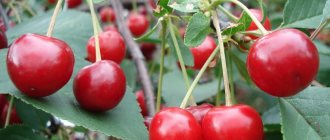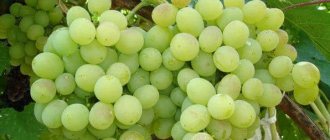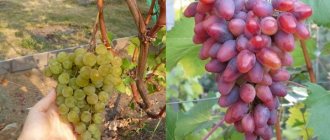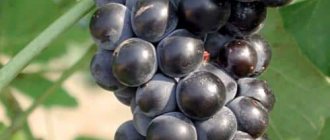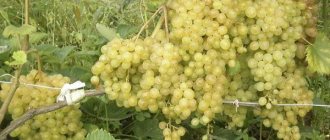Siberian grapes: climatic growing conditions
Growing grapes in Siberia is no longer exotic.
The main thing is to choose the right varieties and provide the plant with special agricultural technology for the given region. The history of this southern culture in the northern regions began about half a century ago. Of course, the ability to cultivate grapes here did not come immediately, since the climatic conditions in this area are special:
- winter is long and frosty;
- significant changes in daily and seasonal temperatures;
- short growing season.
History of Siberian grapes
Grapes appeared in northern latitudes about 70 years ago. Enthusiasts and professionals began actively promoting culture in these areas back in the 40s and 50s. The healing properties of the berry, the ability to obtain a rich harvest, even in the most difficult conditions, the potential for the development of domestic winemaking - all this became the impetus for active development in the area of selection. Even under Stalin's rule, projects were opened to develop frost-resistant varieties.
The next stage of development was the attempts of local breeders and hobbyists to expand plantings to experimental areas, commercial ones, and to make the crops widespread outside the Urals. Clubs and schools of Sharov and Levchenko were created, which made a significant contribution to development.
On a note! Even today the vineyards of the Solovetsky Monastery are widely known. The harsh climate of the White Sea coast did not become an obstacle to the cultivation of several plant varieties at once.
Grape varieties for growing in Siberia
In order to grow grapes in Siberia, it is very important to choose the right varieties, specially bred for harsh climatic conditions. Due to the short warm period, preference should be given to frost-resistant, early-ripening and quickly ripening bushes, taking into account their characteristics and care features.
Augustine
This variety has synonymous names: V 25/20, Pleven resistant, Phenomenon. Bred by NIIViV, Pleven, Bulgaria. A worthy large-fruited table variety. It is characterized by increased resistance to diseases and cold. It is considered unpretentious and consistently fruitful.
- Bisexual, early grape variety (110–115 days), vigorous.
- The bunch is large (300–500 g), conical, of medium density.
- The berries are large, white, oval, weighing 4–5 g, the taste is harmonious.
- The vines ripen up to 80%.
- Sugar content – 19–21%, acid – 6–7 g/l, tasting score – 4.5 points.
- Transportability is high. Commodity.
- Resistance to diseases and frost (-24–25°C).
Agat Donskoy
Bred by Russian breeders VNIIViV named after. Ya. I. Potapenko, also has the name Vityaz. Frost-resistant, disease-resistant and high-yielding.
- Medium ripening period (115–125 days; early September).
- The bushes are vigorous.
- The bunch is large (up to 400 g), conical, medium-dense.
- The berries are large (4–5 g), round, black, insipid in taste.
- Sugar – 13–14%, acid – 6–7 g/l, tasting score – 4.0 points.
- The vines are 85–90% ripe.
- Transportability is average.
- Withstands -27°C, disease resistant.
Muscat white
Technical grade, also called 16–1–23, obtained at NIIALM, Volgograd. Valued for its high sugar content, it is used to make aromatic and tasty Muscat wine.
- Extra early (third–fourth decade of July), medium height.
- The bunch is medium (more than 250 g), cylindrical, dense.
- The berries are round, light yellow (2.5 g), nutmeg aroma.
- Tasting score – 4.5 points.
- Vine ripening up to 90%.
- Frost resistance (-25°C), disease resistance is average.
White Muscat Shatilova
Launched by OSSiV, Orenburg, F.I. Shatilov. A vigorous hybrid with a very large leaf, high-yielding, bisexual. Pruning the entire mature vine, since the inflorescences distant from the head of the bush are larger.
- Early variety (115–120 days).
- The bunch is large (500–1000 g), already in the first year it can be 1500 g, the shape is conical, loose.
- The berry is round, yellow, fleshy with a harmonious nutmeg aroma and pleasant taste, weighing 5–6 g.
- Ripens in mid-August.
- The vines ripen very well, almost completely.
- Frost resistant (-27°C).
Frost-resistant, uncovered variety, suitable for growing in Siberia and the Urals.
Platovsky
A proven variety for risky farming areas. Received from VNIIViV named after. Ya. I. Potapenko. Frost-resistant, the vines recover well after frost. Technical high-yielding wine variety, weakly affected by diseases.
- Technical variety, early ripening (110–115 days), medium-strong growth vigor.
- The clusters are cylindrical, medium in size (200 g), moderately dense.
- The berries are medium (2 g), round, white, pinkish in the sun.
- The taste is harmonious. Sugar – 20%, acid – 8%, vine ripening up to 80%, load – 60 buds, frost resistant (-29°C).
- Wine, high quality.
Beauty of Nikopol
One of the best varieties for Siberia and the Urals. Very early, resistant to mildew, oidium, gray rot. The bushes grow strongly, the shoots ripen well.
- Table grape variety with very early ripening period (105 days).
- In the Rostov region it ripens at the end of July.
- The bunch is medium (400–600 g), medium dense, conical.
- The berry is oval, weight – 4–5 g, purple.
- Productive (one of the best early varieties), highly marketable.
- Sugar – 18–20%.
- The pulp is fleshy and juicy, the taste is harmonious.
15–03–1
A high-yielding variety of Orenburg selection OSSiV, bred by F. I. Shatilov. Suitable for growing in Siberia and the Urals.
- Vigorous.
- The bunch is medium (300 g), conical, very dense.
- The berries are elongated, dark purple, have a simple taste, weight – 4 g.
- Sugar content – 22%, acidity – 6.7%.
- The yield is high - 12–15 kg, frost-resistant (-27°C).
Amursky No. 1
One of the most winter-hardy and hardy varieties. Received at OPSiV, Orenburg, F.I. Shatilov.
- Ultra early variety (80–90 days).
- Ripens in August.
- Bisexual.
- The bunch is small (100–150 g).
- The berries weigh 3–4 g, black, taste pleasant with a floral aroma.
- Sugar – 20–21%.
- The variety is not covered, the vigor is average, the ripening of the vine is 80%.
Amursky No. 2
Many characteristics are similar to the previous variety.
- Bisexual. Bunch – 150–170 g.
- The berries are medium (3–4 g), black, have a pleasant taste, juicy, ripen in August (ripening period - 90 days).
- The yield is high, the vines ripen by 90%, the variety is universal, not covered.
- Sugar – 18–20%.
Delight
Zoned in many regions and in Orenburg, received at VNIIViV named after. Ya. I. Potapenko. The best variety of breeder Kostrikin, the founder variety in the “Vostorgov” family and many other varieties.
- Early (110–120 days).
- Ripens by the second ten days of August.
- The bunch is large (500 g), conical, medium density.
- The berries are large (4–6 g), slightly oval, white.
- The shoots ripen well.
- Sugar – 18–22%, acid – 5–9 g/l.
- Resistance to frost (-25°C) and diseases is high.
- Transportable.
Solovyova-58
The variety will ripen by the last days of summer. Consumed fresh, also good for making wine and juice. The harvest is average, it needs to be rationed, so the bush can be given a compact shape.
The clusters are small, 100-300 g. The berries are white and round, weighing from 2 to 4 g, juicy, with one rudimentary seed. The taste is nutmeg-strawberry.
The variety resists diseases well, takes root easily, and tolerates low temperatures (down to -32°C), but it is also necessary to cover it.
Rusven
The variety takes about 115 days to reach ripeness. In addition to table use, it serves as a raw material for making wine. It bears fruit well, but is not entirely suitable for transportation. The clusters weigh 0.5-1 kg, they have large green berries (5-6 g) with a specific nutmeg aroma.
Grape varieties for the Moscow region
The Moscow region climate is not always kind. However, the hard work of winegrowers made it possible to grow these berries even more successfully than in the southern regions. In northern conditions, many grape diseases and pests disappeared, and the yield of varieties increased threefold. Let's look at the best grape varieties for the Moscow region.
Despite the richness and variety of flavors of grapes, in fact they have only four tastes: sweet and sour, nutmeg, ordinary sweet, nightshade
Kishmish is truly the most popular grape variety. Firstly, it is seedless, secondly, its berries can reach the size of a five-ruble coin, and thirdly, it is very tasty
The “Christina” variety is very popular among grape lovers because of its unpretentiousness and ease of care. For the Moscow region, this variety is suitable like no other
What varieties do professional winegrowers recommend for the Moscow region? Among the best we highlight the following:
- Anniversary of Novocherkassk
. This grape is one of the ten best hybrid varieties in the Moscow region according to expert estimates. Large clusters with large, sweet, pinkish berries are the hallmark of this hybrid. The fruits ripen early, and the vine itself is quite frost-resistant. - Kishmish radiata
. Fragrant, beautiful and very tasty variety. Kishmish berries are sweet with a pink-lilac tint. - Tason
. If you love grapes for their subtle muscat flavor notes, then you will definitely like this variety. Tason berries have pink sides and are quite large. One bunch can feed the whole family for breakfast. - Christina
. Many winegrowers fell in love with this mid-season variety for its sugar fruits and ease of care.
Tason is another grape variety for the Moscow region; its yellow-pink berries will appeal to both children and adults
You should also pay attention to such varieties as Super Extra, Crystal, Rusven, Agat Donskoy, Krasa Severa.
Seeds are the only factor that mars the enjoyment of juicy grapes. And here we are lucky again - in our country, various varieties of seedless grapes have been successfully grown for a long time. The most popular soft-seeded grape is Kishmish.
Kishmish - Asian miracle
It is this variety that we can eat in the winter in the form of raisins, add to baked goods and brew in compotes. Kishmish has several varieties, our favorite of which is White Kishmish. The berries of this variety are endowed with almost magical properties. Asian peoples used Kishmish as a vitamin, cardiac and sedative.
This variety grows most successfully in the central regions of Russia, and, with proper winter care, can also live in the northern lands. Before frost, cover Kishmish with agrofibre, and in the summer it will again delight you with young shoots and sweet, soft, seedless berries.
Early varieties for harsh climates
Early varieties are among the most advantageous for planting in Siberia. The main condition for obtaining berries is the correct awakening of the vine. Careful pruning and timely application of fertilizers will also help to quickly set shoots and direct all the plant’s forces to the formation of a vine and then a bunch.
Red nutmeg
The extra-early variety allows you to get fruits within 90 or 100 days after awakening. This is a good option for regions with the shortest summers. The berries will be ready by the end of July. An important characteristic is the presence, along with acid and sugar, of a bitterish note of taste.
On a note! According to the standard rating scale, the grapes receive an average of 7.7 points for taste.
The berries themselves are dense, fleshy, and the peel is quite thick. Therefore, organizing storage is quite simple, but for making wine it is better to choose another option. The finished drink appears too sharply bitter, which cannot be compensated by the low sugar content. One of the features is the change in color of the shell and pulp. It goes from soft pink to rich burgundy and then dark purple. You can leave the crop on the vine for several weeks after full ripening without fear.
It is worth considering that these grapes do not tolerate frost with temperatures below minus 23 degrees and need protection in winter. Infections with fungal diseases are especially dangerous.
Early Bashkir
One of the recommended species for the Ural region, however, may not survive in more severe weather zones. The variety is different:
- rich harvests even at low humidity;
- resistance to fungi;
- low acidity.
Disadvantages include:
- small berries up to 1 gram;
- small brushes up to 30 grams;
- high acidity.
The variety is used for the production of dry wines. It contains only 14 percent sugar. The dense, thick shell has a pronounced aroma and tart taste, which imparts to the finished drink. It belongs to the early category, since the harvest can be harvested as early as mid-August.
Early Russian
These berries are the first to be harvested: at the end of July they acquire a crimson color, then darken, become soft and gain juice. The grapes are not suitable for long-term storage and are intended for fresh consumption. Early Russian is a table grape variety that is widespread throughout Siberia. The growing season averages 115 days in the middle zone and the same in colder climates.
The height of the plant is small, it grows in width and can occupy up to five meters. This variety is chosen because:
- has berries weighing up to 7 grams;
- has a bright caramel taste and smell;
- tolerates transportation and storage well.
The berries are fleshy and juicy, but require good moisture. If kept too dry, the crop may begin to crack.
On a note! You should not expect results from this variety in the first 2-3 years after planting. It actively forms tree bark, and in the future it is recommended to reduce the number of fruiting branches to obtain larger berries.
Tukay
Tukay was obtained as a result of long-term crossing of a simpler, but persistent, Central Asian variety with a dessert type of nutmeg taste. The result was ultra-early plants, which are classified as dessert plants.
On tall bushes, up to 3 meters each, very large clusters weighing up to 800 grams are formed. Even in Siberian conditions, you can get a harvest of one kilogram from each formation. The bushes are vigorous and actively form greenery throughout the growing season, so they can also be used as a partially decorative planting. Strengths of this variety:
- dense skin that preserves fleshy berries;
- bright nutmeg taste and aroma;
- a dense bunch that does not crumble.
The plant is not afraid of wasps and does not require additional pollination. For full ripening in 90-95 days, a consistently high temperature is not required. Warming up to 18-20 degrees during the summer is enough. Already at the end of July, you can cut the first bunches, which, if properly stored, will retain their properties for more than 4 months.
Codrianca
This is one of the classic southern varieties, however, its hybrid properties are highly valued in regions of risky farming. The growing season is only 110 days, which makes it possible to grow grapes in Siberian conditions. The berry has a rich black color, slightly viscous and sour taste. The main advantage is the variety of ways to use it. Fresh, frozen, in home-made preparations, as a base for wine - Kodryanka is suitable everywhere.
The variety is quite demanding to care for. Its indicators vary greatly depending on agricultural practices. A vine that is not too thick will be overloaded with bunches, so it is necessary to limit the number of fruiting buds. The fewer of them there are, the larger one formation will be, but also the higher the risk that there will be many unpollinated ones left, and the overall level of productivity will fall. Partial pollination is the main disadvantage of the hybrid.
On a note! Plant owners often leave 2 formations in each bunch. This is the optimal amount for pollination and for obtaining large enough fruits.
One of the main advantages is resistance to spring freezing. In the absence of a supplyable snow layer, additional shelter will be required in winter, since average survival rates are at -22 degrees Celsius.
Guests from overseas: varieties from the USA
Not all amateurs and professionals like seedlings from the USA, however, they have undeniable advantages. Most modern varieties are bred from Vitis labrusca; in its homeland the plant was called fox berry. The main difference is a light strawberry flavor, high juice content and excellent sugar accumulation properties. According to the latter indicator, these types of grapes are superior to many covering varieties.
Alpha
Among professionals, the American Alpha variety is often called technical, that is, more suitable for landscaping or amateur maintenance, but not for industrial winemaking. It is especially widespread at the latitude of Kharkov, where it is cultivated in large quantities; however, it became in demand about 15 years ago in Siberia as a variety for private cultivation.
Benefits include:
- unique pollinator properties of other varieties;
- frost resistance up to 30 degrees below zero;
- dark color of berries and rich taste;
- the presence of so-called “Isabella” flavor notes.
Disadvantages include:
- vigorous growth and significant thickening;
- small berry size, light bunch weight;
- high acid content in berries.
The seedlings take root well, as do the cuttings. The main task when starting to grow is to prevent the vines from becoming too thick, which will reduce the yield. The best performance in Siberian conditions is given by plants that have undergone preliminary hardening at low temperatures and low humidity. Despite the fact that the bush is vigorous, its length is not too long, which allows you to collect a maximum harvest. The variety has a long growing season, from 130 to 145 days, however, due to its frost resistance, it is still suitable for regions of risky farming.
Lando Noir
Unlike the Alpha variety, this grape is recommended for making red wines, especially fruity semi-dry and semi-sweet ones. The minimum acid content and high sugar concentration make it possible to obtain a drink with excellent taste characteristics.
On a note!
Landau Noir is one of the best varieties suitable for cultivation in Siberia, which is used to make so-called “aging” wines.
The berries have an even round shape and medium size. They are approximately the same in weight, which makes processing convenient. The variety itself is classified as a French-American hybrid. Its advantages:
- short growing season;
- frost resistance up to 30 degrees below zero;
- late blooming of “eyes”;
- resistance to fungal infections.
Despite the fact that Lando Noir is an early variety, the “eyes” of the buds open very late, so they are not damaged by the May frosts that are frequent in Siberia.
Somerset Seedleys
This variety, originally from the USA, is one of the most frost-resistant. Despite the fact that the official description provides for survival only at minus 35 degrees, the plants themselves, with proper preparation and proper awakening, can withstand significantly lower temperatures. The variety is attractive due to the following characteristics:
- delicate pink color;
- high productivity;
- low bushiness;
- absence of seeds.
Its disadvantages include:
- low sugar content;
- abundance of small berries;
- small bunch size.
The first harvest can be harvested at the end of August, since this is a record early grape variety. Despite the fact that the clusters are numerous, it is quite rare to obtain a large volume of berries. The weight of one fruit cluster is within 200-250 grams. The berry has no bones, which greatly simplifies its processing. One of the characteristics is resistance to the most common pathology of this plant species - downy mildew.
Particularly resistant non-covering hybrids
There are grape hybrids whose bushes are able to withstand especially low temperatures and at the same time exhibit accelerated growth rates. The fruits ripen quickly and require less heat. This makes it possible to grow such crops in high-risk areas with harsh winters and unpredictable summer weather.
Recommended winter-hardy varieties of American selection:
- Reline Pink Seedlis is the most frost-resistant American hybrid (down to -27°C). The fruits are pink, seedless, with a labrusca aroma, suitable for drying, making juices, wine, and eaten fresh. Ripening dates are very early (105 days). Permissible load - 50 eyes per bush.
- Taiga emerald is a hybrid from the Primorsky Territory, obtained from the American variety Minnesota. The berries are consumed fresh, their sugar content reaches 19.5%. The shoots of this high-yielding variety manage to ripen during the short autumn. It has high frost resistance and is tolerant to mildew.
- Valiant is a super winter-hardy species, the vine can withstand temperatures down to -47°C. Early ripening. The berries are black and blue with large seeds and a fruity aroma. Some samples had a strawberry flavor. The clusters are moderately dense and can remain on the bushes for a long time.
- Triumph is an American table variety with vigorous shoots, long conical clusters and large oval fruits. Ripens in the second half of August. Capable of increasing varietal characteristics with age.
The best early-ripening, mid-ripening and late-ripening grape varieties
Among the early varieties, summer residents distinguish Augustine grapes. Table variety, ripening period - 100-110 days. The weight of the conical bunch is about 500 g, the berries are dense, with a pleasant sweet taste. The variety is self-fertile and transportable, universal in use. Frost resistance - down to -25°C.
White Muscat grapes are also in demand among early-ripening varieties. In terms of ripening period, it is medium early. The berries are round, the weight of the bunch is 100-180 g. The color is sweet, the aroma is nutmeg. Early grapes are used for fresh consumption and processing. To obtain a rich harvest, it is recommended to cover early ripening varieties for the winter.
Of the mid-season varieties, it is recommended to pay attention to the Beauty of the North. The ripening period is 115-120 days, the harvest is harvested in late August or early September. The clusters are loose, weight - about 250 g. The berries are large, white-pink in color. The pulp is juicy with small seeds, the taste is sweet, the aroma is pleasant grape. A table variety, the harvest is suitable for processing and fresh consumption.
The late-ripening variety Pamyati Verderevsky is also popular among summer residents. The plant produces large ovoid berries, the weight of one is 6-7 g. The clusters are of medium density, conical, weighing 300-400 g. The harvest is stored for 4-5 months without loss of taste and marketability, frost resistance - down to -24°C. The shoots ripen quickly and the yield is stable. Resistance to mildew and spider mites is high.
Interesting! Of the late varieties, gardeners distinguish Dekabrsky, Red Globe, Original, and Dachny. In Altai and Siberia they are planted in spacious and well-lit areas next to low-growing plants. If you plant grapes in shade or partial shade or next to tall bushes, this will negatively affect the yield.
How to choose the right variety
To grow a healthy bush that will produce a good harvest, you need to learn how to choose the right variety.
The following characteristics are taken into account:
- Direction. It is necessary to decide for what purpose the grapes will be grown: table, industrial or universal.
- Winter hardiness. Only frost-resistant varieties that tolerate temperatures of -25°C and below are suitable for Siberia.
- Productivity. This is an indicator that characterizes the productivity of a variety.
- Ripening time. High yields in frosty conditions can only be achieved by early varieties.
How to grow grapes in Siberia
Having decided on the choice of grape variety for Siberia, you can start purchasing planting material. However, it is important to immediately create favorable conditions for good survival, so you should prepare.
The question of how to grow grapes in Siberia worries every gardener, since agricultural technology differs from other regions. Caring for this crop has some aspects that should be followed. Then, over time, the vineyard develops resistance to temperature changes, and the growing season shortens. As a result, its cultivation after a few years will be as simple as in the southern regions.
Planting takes place in late April - early May. If the variety is frost-resistant, then it can be grown in the fall, but you will need to cover the plant with spruce branches and insulating material.
The planting site should be chosen in the same way as for varieties in the southern regions, but with the condition that a trench can be dug in this area.
Winter-hardy varieties can withstand severe frosts
The best place for planting grapes in the regions of the Urals and Siberia are the southern and southwestern areas.
They should warm up well and be illuminated by the rays of the sun. They must be protected from cold winds by the walls of buildings. Its cultivation greatly influences the growth of grapes in cold regions. Nowadays, grape varieties have been developed that are not only frost-resistant, but also winter-hardy. Some people believe that these two criteria are equivalent, but this is not the case.
The first include varieties that can withstand short-term drops in temperature. Winter-hardy varieties are able to survive in severe frosts, not survive under large snowdrifts and ice crust, and also not die from drying winter winds, etc.
Features of planting and growing
For planting in the northern regions, it is better to choose May or June, although frost-resistant varieties take root well in the fall. The main thing is that on the day of planting the soil temperature is not lower than +15°C.
The bed for placing bushes should be located from north to south. A planting ditch 60–70 cm deep is dug along the line. The edges of the trench can be left either sloping or vertical.
All weeds are removed. The soil at the bottom of the ditch is dug up (depth 25–30 cm) and fertilizers are applied.
For one vine you need:
- manure - 1 bucket;
- superphosphate - 200 g;
- wood (vegetable) ash - glass.
Then, holes 50–60 cm deep are dug in the trench for each vine. The distance between future bushes should be 2–2.5 m.
Seedlings are chosen one- or two-year-old. Before planting, the cuttings are treated: the heel roots are shortened, leaving 10–12 cm, and soaked for a day in Heteroauxin.
Prepared seedlings are lowered into a hole so that the top protrudes slightly from it. The roots are covered with soil from above and watered with warm water (near a bucket). Then the hole is completely dug in. There should be 10–15 cm of shoot above the ground. The tree trunk circle is covered with mulch (straw or wood chips).
Wooden beams 2–2.5 m long are dug in as a support for the vine. Wire is stretched between them at different heights.
Caring for young seedlings
After spring planting, grape seedlings must be watered - in this case, watering should be rare, but quite plentiful. As a rule, it is enough to pour 2-3 buckets of water under each grape bush once a week. Watering should continue until mid-August, after which it is stopped.
A very important stage in growing a vineyard in Siberian conditions is timely pruning of the plant. Many experienced winegrowers advise, if possible, not to prune the grape bush in the first 1-2 years after planting, since it is at this time that the formation of a strong, mature vine occurs.
Pruning of the grapevine should begin in September, carefully removing all damaged and dry branches, weakened shoots, as well as vines that have already produced berries. It is strictly not recommended to prune garden plants in the spring, since due to the climatic characteristics of the Siberian region, grapes bloom at this time.
It is extremely important to strictly control bush density and crop load. For this purpose, stepsons, tendrils, and extra bunches are removed. The fruiting vine must be completely pruned; it is recommended to leave no more than a few grape shoots. In the first year after planting, no more than 20 buds should remain on one bush; the number of buds can be increased every year. This will help maintain the optimal load for the grape bush, and the grapes in Siberia will produce a bountiful harvest.
The positive aspects of growing grapes in Siberia include the fact that winter varieties of garden plants are highly resistant not only to Siberian frosts, but also to numerous grape diseases and pests, which will be a pleasant discovery for beginning winegrowers.
Agricultural technology
To grow good crops in Siberia, it is worth paying special attention to the necessary agrotechnical stages and ensuring:
- sufficient watering;
- fertilizing plants in the required quantities;
- correct pruning;
- reliable insulation for the winter.
Timely implementation of the above steps allows you to form a healthy plant that calmly reacts to winter cold.
Top dressing
It is impossible to grow a good harvest without feeding plants. Preliminary preparation of the planting pit with a large amount of humus and the application of phosphorus-potassium fertilizers provides the plant with a sufficient amount of necessary microelements for several years. Only in the third or fourth year do they begin to feed the grapes.
in spring
To grow large harvests, you need to care for the grapes all year round and take care of their health from early spring to late autumn. While the grapes are not blooming, they are fed with mineral fertilizers and boric acid. This is necessary for abundant flowering and fruit formation. The second spring feeding is carried out using phosphorus-containing fertilizers.
In summer
In July, the grapes are fed with nitrogen-containing fertilizers. In August, the introduction of nitrogen is excluded. In the second half of summer, ash infusion, superphosphate and mineral fertilizers are used.
During the ripening period, the use of boric acid will help increase the sugar content of the grapes.
in autumn
Proper care of grapes in the fall ensures that the bush is well prepared for winter. After harvesting, it is fed with complex fertilizers. This feeding will saturate the plant with essential microelements. Mulching with rotted manure and subsequent abundant watering will saturate the soil in the root zone with organic fertilizers in the required volume.
Watering
Water the young seedling every two weeks and carefully ensure that the soil remains slightly moist. An adult plant, depending on weather conditions, is irrigated at least 4-5 times per season. Watering is stopped after pouring the berries. In October, the vineyard is well saturated with moisture, helping to prepare for winter.
Mulch
To avoid numerous weedings during the summer, retain moisture and protect the roots from freezing, the soil under the grapes is mulched. To do this, use spruce branches, straw or dry grass.
Formation
Three-year-old bushes require formation. The work is carried out in the fall, after the harvest and leaves fall.
Trimming
The first stage of pruning is carried out in the following sequence:
- remove dry and damaged shoots;
- cut out the weak;
- remove the fruiting vine.
Before covering the grapes for the winter, a second stage of pruning is carried out. Of the two shoots growing nearby, the most developed one is left. The second is cut off, leaving one leaf.
Pinching
To form a fruiting vine and develop ovaries, shoots are pinched. Pinching accelerates the growth of the bush and correctly forms the crown.
Stepsoning
Stepchildren or shoots of the second row use a lot of nutrients and often cause their deficiency in fruiting shoots. Removing stepchildren will increase the level of fruiting. When 5-6 leaves form on them, they are pinched. Leave one leaf at the base.
If the main shoots are severely damaged as a result of return frosts, the grapes are not planted.
Garter
It will prevent chaotic growth of the vine and make it easier to care for the grapes by tying them up. Vertical trellises with wire stretched horizontally are used as supports. The bottom row of grapes is planted at a height of about 40 cm from the ground. The number of tiers depends on the age of the bush and does not exceed six.
Hardening
Hardening will make life easier for the grapes and prepare them for Siberian frosts. The first hardening of seedlings is carried out before planting in open ground: They are taken out of the room into fresh air, gradually increasing the interval.
Hardening off grapes in open ground involves minimal intervention. As a result, the plant grows stronger and quickly adapts to natural conditions.
Shelter for the winter
Grapes in Siberia are grown only under cover. When the average daily temperature reaches zero, insulation begins. It is carried out in the following sequence:
- Choose a dry, sunny day for work. In the event of recent rains, expect the plants to dry completely: this will prevent moisture from getting under the shelter and the spread of the fungus.
- The vine is removed from the trellis and carefully placed in a trench on a dry bedding.
- The vineyard is completely covered with film or fabric material, securing it well. The top can be covered with spruce branches or any branches.
With the beginning of spring sap flow, the coniferous spruce branches and film are removed, leaving only covering material, or a greenhouse is installed on arches. Insulation is completely removed only at the end of spring, when the weather stabilizes.

